Sojitz Bundle
What's the Story Behind Sojitz's Global Success?
Delve into the captivating Sojitz SWOT Analysis to uncover the strategic brilliance behind a global trading giant. From its humble beginnings to its current status, the Sojitz company story is a compelling narrative of adaptation and expansion. Discover how this Japanese trading company has shaped international commerce.
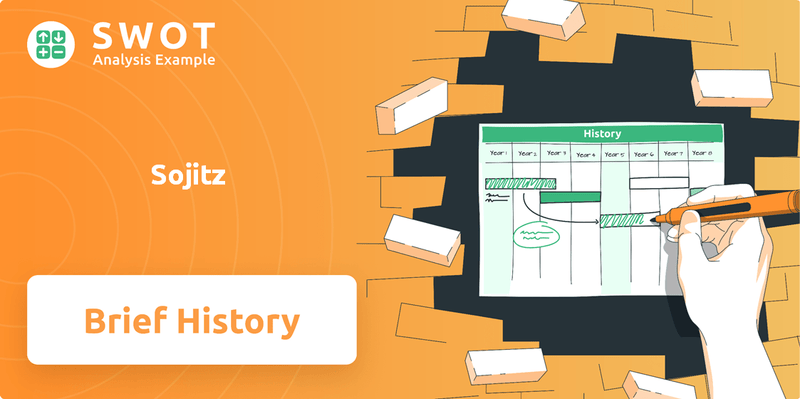
The Sojitz group's Sojitz history is a testament to its resilience and foresight. Tracing back to the late 19th century, this Sojitz company has consistently evolved, navigating economic shifts and forging strategic alliances. Understanding the Sojitz overview and Sojitz timeline offers invaluable insights into its enduring influence on global markets.
What is the Sojitz Founding Story?
The story of the Sojitz Corporation is a tale of strategic mergers and adaptation within the dynamic world of Japanese trading companies. The company's roots trace back to the consolidation of two significant players: Nichimen Corporation and Nissho Iwai Corporation. This union was a response to the changing global landscape, emphasizing efficiency and strategic alliances.
Formally established in April 2004, Sojitz's foundation was laid a year earlier with the creation of Nissho Iwai-Nichimen Holdings Corporation in April 2003. This holding company was a critical step in integrating the businesses of Nichimen and Nissho Iwai. The goal was to navigate the complexities of global standardization and to enhance competitiveness.
The Target Market of Sojitz has evolved significantly since its inception. The company's history reflects Japan's industrial and economic shifts, making it a key player in global trade.
The history of Sojitz's predecessors offers insights into the company's current structure and business activities. Nichimen Corporation, originally Japan Cotton Trading Co., Ltd., was founded in 1892, while Nissho Iwai Corporation emerged from mergers in 1968.
- Japan Cotton Trading Co., Ltd. (Nippon Menka Kabushiki Kaisha) was founded in Osaka in 1892.
- Nissho Iwai Corporation was formed in 1968 through the merger of Nissho Company (founded 1902) and Iwai Sangyo Company (founded 1901).
- These companies played important roles in Japan's industrial revolution and post-war recovery.
The initial business models of these companies centered around commodity trading. Nippon Menka focused on cotton, while Iwai & Company dealt with steel. Nissho Company traded sugar and later expanded into various sectors. The merger into Sojitz allowed for a diversified portfolio.
- Nippon Menka started by importing raw cotton and later exported cotton yarn and cloth.
- Iwai & Company began as a steel trading firm and diversified.
- Nissho Company traded sugar and expanded into flour, steel, tobacco, and more.
The name 'Sojitz' symbolizes the merger of equals, derived from the '日' (sun) in both Nissho Iwai and Nichimen. This strategic move combined the strengths of the two companies, allowing them to operate in diverse sectors.
- The name 'Sojitz' represents a new beginning and a merger of equals.
- The company operates in sectors like information and communications, building materials, and more.
- The merger was a strategic response to global market changes.
Sojitz SWOT Analysis
- Complete SWOT Breakdown
- Fully Customizable
- Editable in Excel & Word
- Professional Formatting
- Investor-Ready Format
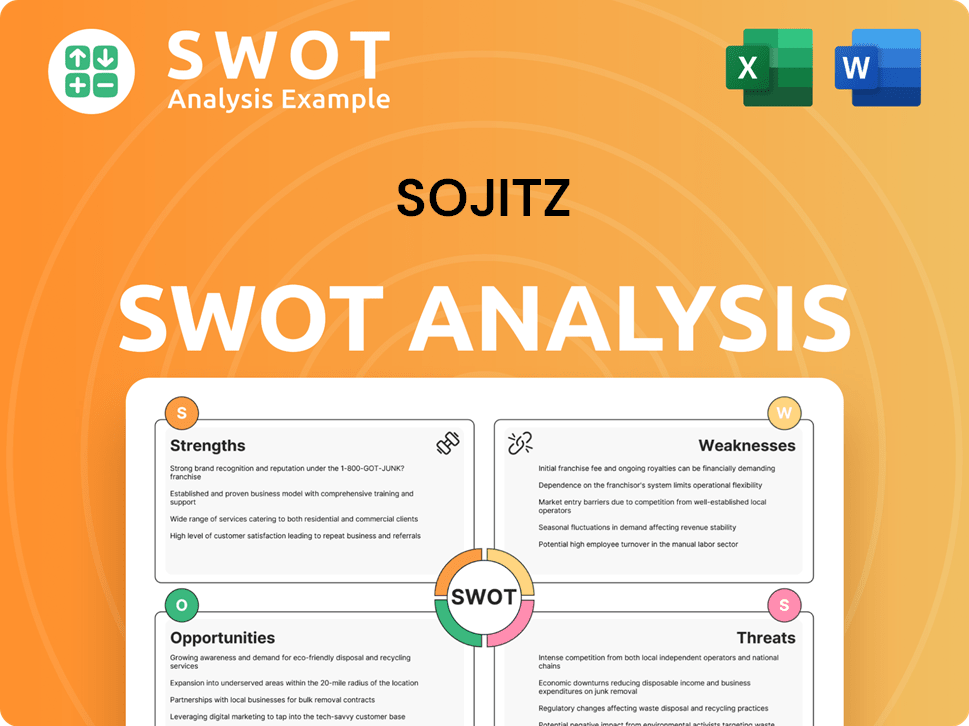
What Drove the Early Growth of Sojitz?
The early growth and expansion of the Sojitz group were marked by strategic integration and global market diversification. Following the 2004 merger, the company utilized the combined strengths of Nichimen and Nissho Iwai. This period was crucial in establishing its presence across various sectors. The brief history of Sojitz Corporation reflects a dynamic evolution.
In its first fiscal year after the merger (2003, as the holding company), the Sojitz company reported revenues of approximately JPY 3.3 trillion (around USD 30 billion). This financial milestone highlighted its significant entry into the competitive Japanese trading industry. This early financial success set the stage for future growth and expansion.
Key developments included expanding its international presence and diversifying its business portfolio. By 2023, overseas sales contributed approximately 60% of Sojitz's total revenue, demonstrating its global reach. The Sojitz overview shows the company systematically entered new markets, such as establishing a joint venture in Vietnam in 2021 for the textile business.
The Sojitz timeline shows the company's business model evolved to include trading, manufacturing, project development, and investment activities. This diversification spanned sectors like automotive, energy, and mineral resources. For example, in 2022, trading operations in the chemicals segment generated around JPY 1.04 trillion in revenue, driven by demand for petrochemicals.
The Industrial Infrastructure Business contributed approximately JPY 36.3 billion to overall profit in 2022. This period involved continuous efforts in asset recycling and profitability improvement, with substantial resource allocations aligned with its corporate strategy. For more context, consider the Competitors Landscape of Sojitz.
Sojitz PESTLE Analysis
- Covers All 6 PESTLE Categories
- No Research Needed – Save Hours of Work
- Built by Experts, Trusted by Consultants
- Instant Download, Ready to Use
- 100% Editable, Fully Customizable
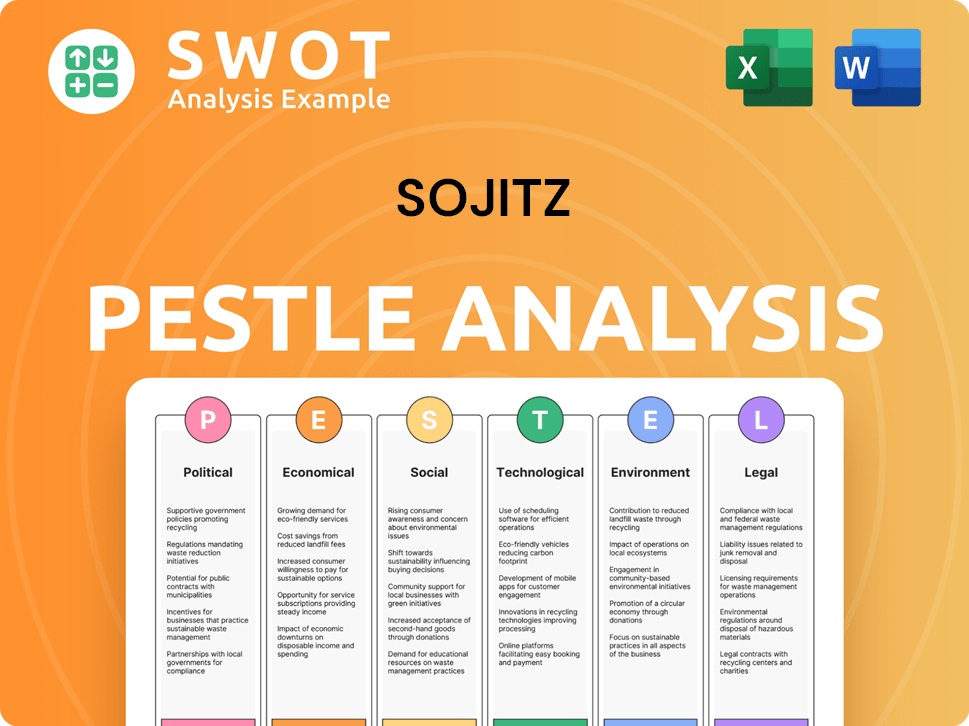
What are the key Milestones in Sojitz history?
The Sojitz history is marked by significant strategic moves and expansions, solidifying its position as a major player in global trade. A key aspect of the
| Year | Milestone |
|---|---|
| 2004 | Merger of Nichimen Corporation and Nissho Iwai Corporation, forming Sojitz. |
| 2025 | Acquisition of a majority stake in NIPPON A&L INC., expanding into manufacturing for resin and latex fields. |
| FY2024 (ending March 31, 2025) | Net profit exceeded the full-year plan, demonstrating resilience in a challenging market. |
In terms of innovation, the
The company is actively transitioning from petroleum-based products to biosynthesized and eco-friendly alternatives. This move aligns with the global demand for a decarbonized society, showcasing the company's forward-thinking approach.
In 2025, Sojitz acquired a majority stake in NIPPON A&L INC. This strategic move strengthens the chemical business by expanding into manufacturing for resin and latex fields. The expansion is particularly relevant to electric vehicles (EV) and storage batteries.
In FY2024, Sojitz invested in the AI startup Degas Ltd. This showcases a commitment to leveraging digital technologies. The goal is to enhance earning power and maintain a competitive edge.
Sojitz has faced various challenges, including economic fluctuations and market downturns, like other Japanese trading company. The company's ability to transform challenges into opportunities is a key strength.
The collapse of the Japanese asset price bubble in the early 1990s significantly impacted its predecessor, Nichimen. This led to a strategic shift towards 'hard' businesses like machinery and steel.
Sojitz consistently pursues portfolio transformation for sustainable value creation. The aim is to form 'Katamari' (revenue-generating business clusters) by enhancing existing businesses and making new investments.
Despite negative market conditions, Sojitz has demonstrated resilience by expanding business and capturing earnings. This is evident in its FY2024 net profit, which exceeded the full-year plan, showing the company's adaptability.
Sojitz Business Model Canvas
- Complete 9-Block Business Model Canvas
- Effortlessly Communicate Your Business Strategy
- Investor-Ready BMC Format
- 100% Editable and Customizable
- Clear and Structured Layout
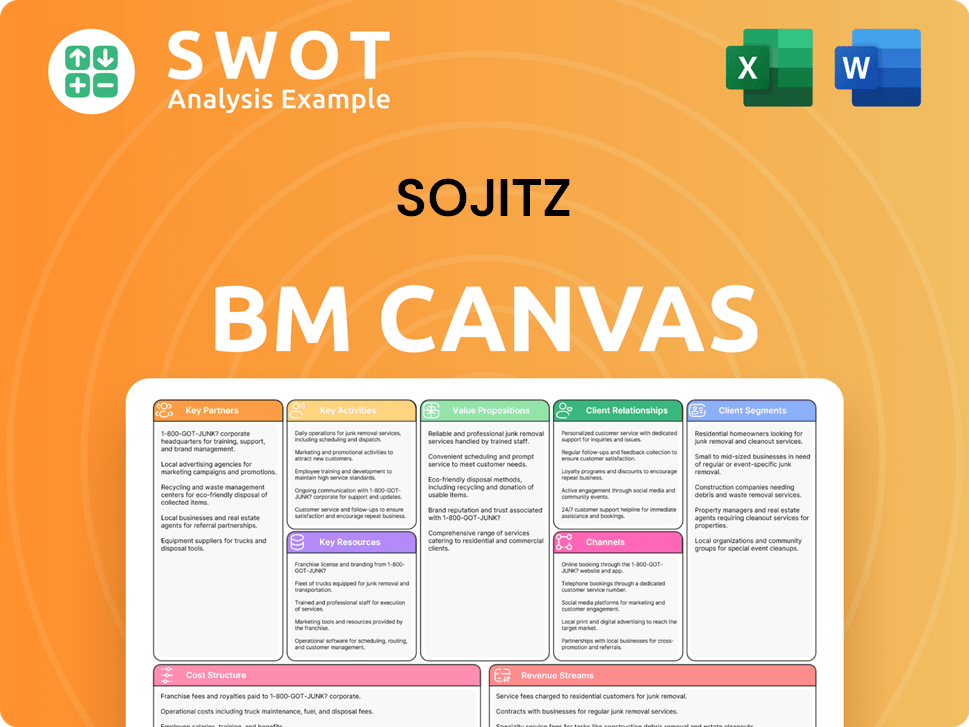
What is the Timeline of Key Events for Sojitz?
The Sojitz history is marked by strategic mergers and global expansion, starting with its predecessors in the late 19th century. The evolution from raw cotton trading to a diversified global player showcases its adaptability. Key milestones include the formation of the Nissho Iwai-Nichimen Holdings Corporation and the subsequent merger to create Sojitz Corporation, solidifying its position in international trade and investment.
| Year | Key Event |
|---|---|
| 1892 | Japan Cotton Trading Co., Ltd. (Nippon Menka Kabushiki Kaisha), a predecessor of Nichimen Corporation, is established in Osaka. |
| 1901 | Iwai & Co., a predecessor of Nissho Iwai Corporation, is founded as a steel trading firm. |
| 1902 | Suzuki & Company, another predecessor of Nissho Iwai Corporation, is founded in Kobe. |
| 1943 | Japan Cotton Trading Co., Ltd. changes its name to Nichimen Co., Ltd., reflecting its diversified operations. |
| 1968 | Nissho Company and Iwai Sangyo Company merge to form Nissho Iwai Corporation. |
| 1982 | Nichimen Co., Ltd. changes its name to Nichimen Corporation. |
| April 2003 | Nissho Iwai-Nichimen Holdings Corporation is established as a joint holding company for Nichimen Corporation and Nissho Iwai Corporation. |
| April 2004 | Nichimen Corporation and Nissho Iwai Corporation merge to form Sojitz Corporation. |
| October 2005 | Sojitz Holdings Corporation merges with its subsidiary Sojitz Corporation, and the company name becomes Sojitz Corporation. |
| November 2015 | Sojitz acquires a roughly 40% ownership interest in Cad Railway Industries (CADRI), a Canadian railcar MRO business. |
| July 2024 | Sojitz acquires full ownership of a U.S. railcar repair company, expanding its MRO business in North America. |
| August 2024 | Sojitz signs a purchase agreement with General Atomics Aeronautical Systems, Inc. to provide unmanned aircraft systems to the Japan Coast Guard. |
| January 2025 | Sojitz, BETA, Yamato HD, and City of Kitakyushu sign an agreement for joint verification testing of air cargo by electric aircraft at Kitakyushu Airport. |
| March 2025 | Sojitz conducts a partial transfer of shares held in Sojitz Senpaku Corporation. |
| May 2025 | Sojitz announces a net profit of JPY 110.6 billion for the fiscal year ended March 31, 2025, exceeding its full-year plan; also, Sojitz acquires a majority stake in NIPPON A&L INC. |
Sojitz aims to achieve a net profit of JPY 200.0 billion, an ROE of 15%, and a market capitalization of JPY 2 trillion by 2030. This ambitious plan involves doubling the company's corporate value. The company is actively investing in growth areas and human capital.
Key strategies include expanding new investments and enhancing existing businesses through 'Katamari' or revenue-generating business clusters. Sojitz focuses on energy and materials solutions, strengthening its automotive business, and expanding in aerospace, transportation, and infrastructure. The company anticipates around 5% annual growth in airport operation businesses in the Asia-Pacific region.
Sojitz is committed to digital transformation and decarbonization solutions, including next-generation air mobility and sustainable manufacturing. The chemicals division is focused on creating next-generation businesses aligned with a low-carbon and eco-friendly society. The company's strategic direction emphasizes sustainability and innovation.
For the fiscal year ending March 31, 2026, Sojitz aims for further profit growth, planning for a substantial JPY 120.0 billion in net profit. This reflects the company's continuous efforts to enhance its business portfolio and create sustainable value.
Sojitz Porter's Five Forces Analysis
- Covers All 5 Competitive Forces in Detail
- Structured for Consultants, Students, and Founders
- 100% Editable in Microsoft Word & Excel
- Instant Digital Download – Use Immediately
- Compatible with Mac & PC – Fully Unlocked
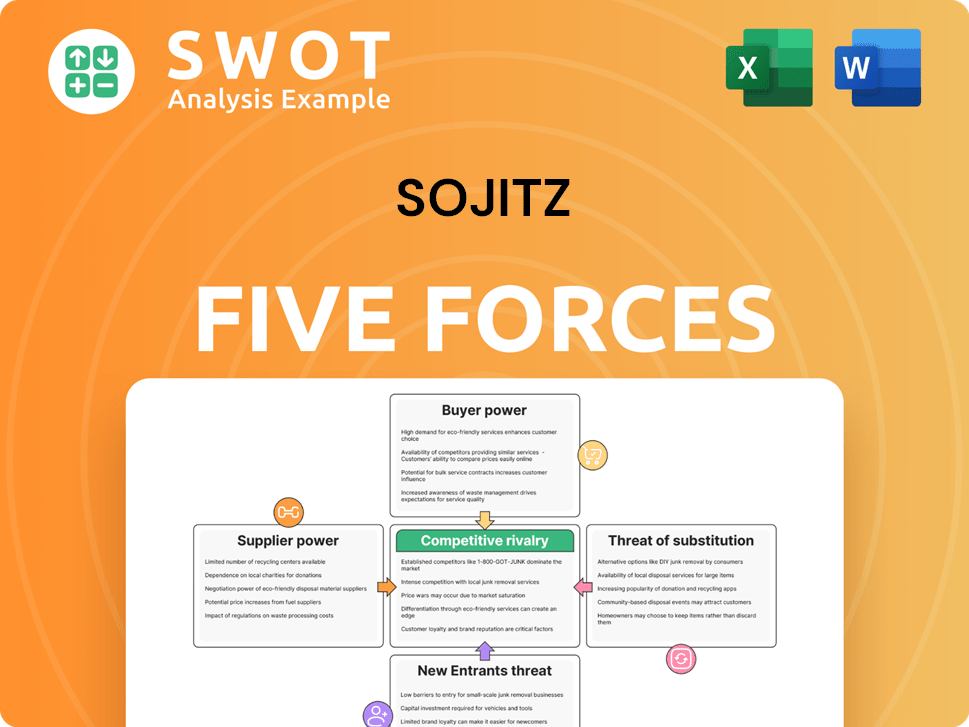
Related Blogs
- What is Competitive Landscape of Sojitz Company?
- What is Growth Strategy and Future Prospects of Sojitz Company?
- How Does Sojitz Company Work?
- What is Sales and Marketing Strategy of Sojitz Company?
- What is Brief History of Sojitz Company?
- Who Owns Sojitz Company?
- What is Customer Demographics and Target Market of Sojitz Company?
Disclaimer
All information, articles, and product details provided on this website are for general informational and educational purposes only. We do not claim any ownership over, nor do we intend to infringe upon, any trademarks, copyrights, logos, brand names, or other intellectual property mentioned or depicted on this site. Such intellectual property remains the property of its respective owners, and any references here are made solely for identification or informational purposes, without implying any affiliation, endorsement, or partnership.
We make no representations or warranties, express or implied, regarding the accuracy, completeness, or suitability of any content or products presented. Nothing on this website should be construed as legal, tax, investment, financial, medical, or other professional advice. In addition, no part of this site—including articles or product references—constitutes a solicitation, recommendation, endorsement, advertisement, or offer to buy or sell any securities, franchises, or other financial instruments, particularly in jurisdictions where such activity would be unlawful.
All content is of a general nature and may not address the specific circumstances of any individual or entity. It is not a substitute for professional advice or services. Any actions you take based on the information provided here are strictly at your own risk. You accept full responsibility for any decisions or outcomes arising from your use of this website and agree to release us from any liability in connection with your use of, or reliance upon, the content or products found herein.